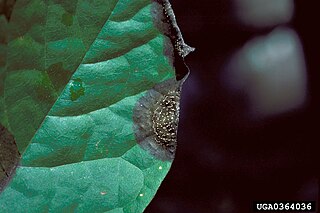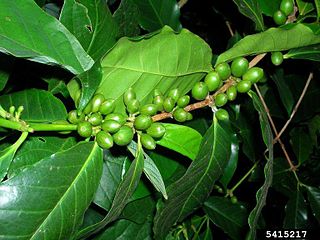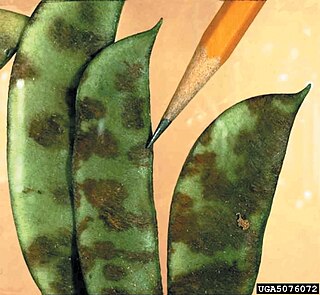Glomerella graminicola is an economically important crop parasite affecting both wheat and maize where it causes the plant disease Anthracnose Leaf Blight.

Botryosphaeria dothidea is a plant pathogen that causes the formation of cankers on a wide variety of tree and shrub species. It has been reported on several hundred plant hosts and on all continents except Antarctica. B. dothidea was redefined in 2004, and some reports of its host range from prior to that time likely include species that have since been placed in another genus. Even so, B. dothidea has since been identified on a number of woody plants—including grape, mango, olive, eucalyptus, maple, and oak, among others—and is still expected to have a broad geographical distribution. While it is best known as a pathogen, the species has also been identified as an endophyte, existing in association with plant tissues on which disease symptoms were not observed. It can colonize some fruits, in addition to woody tissues.

Colletotrichum acutatum is a plant pathogen and endophyte. It is the organism that causes the most destructive fungal disease, anthracnose, of lupin species worldwide. It also causes the disease postbloom fruit drop on many varieties of citrus, especially Valencia and navel oranges in Florida.

Colletotrichum kahawae is a fungal plant pathogen that causes coffee berry disease (CBD) on Coffea arabica crops. The pathogen is an ascomycete that reproduces asexually. The asexual spores (conidia) are stored within acervuli. This disease is considered to be one of the major factors hampering C.arabica production in the African continent, which represents the current geographic range of the fungus. Coffee berry disease causes dark necrosis in spots and causes the green berries of the coffee to drop prematurely. High humidity, relatively warm temperatures, and high altitude are ideal for disease formation. Given the severity of the disease and the lack of effective control measures, there is great concern that the fungus may spread to other coffee producing continents, such as South America, which could have catastrophic consequences.
Crown rot of wheat is caused by the fungal pathogen Fusarium pseudograminearum. F. pseudograminearum is a member of the fungal phylum Ascomycota and is also known as Gibberella coronicola (teleomorph). It is a monoecious fungus, meaning it does not require another host other than wheat to complete its life cycle. Although F. pseudograminearum can produce both anamorphic and teleomorphic states, the teleomorph is usually not present for crown rot of wheat. This Fusarium species has, until recently, been considered to be the same as the species known as Fusarium graminearum due to many similar characteristics. One of the only differences between the two species is that F. pseudograminearum lacks its sexual stage on the wheat host.
Ceratocystis paradoxa or Black Rot of Pineapple is a plant pathogen that is a fungus, part of the phylum Ascomycota. It is characterized as the teleomorph or sexual reproduction stage of infection. This stage contains ascocarps, or sacs/fruiting bodies, which contain the sexually produced inoculating ascospores. These are the structures which are used primarily to survive long periods of time or overwinter to prepare for the next growing season of its host. Unfortunately, the sexual stage is not often seen in the natural field but instead the anamorph, or asexual stage is more commonly seen. This asexual stage name is Thielaviopsis paradoxa and is the common cause of Black rot or stem-end rot of its hosts.

Diaporthe helianthi is a fungal pathogen that causes Phomopsis stem canker of sunflowers. In sunflowers, Phomopsis helianthi is the causative agent behind stem canker. Its primary symptom is the production of large canker lesions on the stems of sunflower plants. These lesions can eventually lead to lodging and plant death. This disease has been shown to be particularly devastating in southern and eastern regions of Europe, although it can also be found in the United States and Australia. While cultural control practices are the primary method of controlling for Stem Canker, there have been a few resistant cultivars developed in regions of Europe where the disease is most severe.
Elsinoë mangiferae, common name "mango scab", is also known Denticularia mangiferae or Sphaceloma mangiferae (anamorph). It is an ascomycete plant pathogen native to tropical regions and specific for survival on only one host, the mango. Originally described in 1943 from Florida and Cuba specimens, this pathogen has since spread worldwide and is becoming a pathogen of great concern for the mango industries in Australia and India. The species was first described formally in 1946.

Oidium mangiferae is a plant pathogen that infects mango trees causing powdery mildew. Powdery mildew of mango is an Ascomycete pathogen of the Erysiphales family that was initially described by Berthet in 1914, using samples collected from Brazil. O. mangiferae is found in all areas where mangoes have been raised long term, but is particularly widespread in India where both the host and the pathogen are native. Currently no teleomorph stage has been identified, but due to certain morphological characteristics it has been suggested that O. mangiferae belongs in the Erysiphe polygony group. Mango is the only known host for this pathogen, though O. mangiferae appears to be identical to fungi responsible for powdery mildew diseases on various other plant species, particularly oak, though some differences may be observed. In particular, the number of cells in conidiophores varies from 2 on mango to 3-5 on oak. O. mangiferae has been known to infect oak leaves in the laboratory, however due to the lack of a known teleomorph stage O. mangiferae is still considered to only be a pathogen of mango. Recent analysis of its ribosomal DNA suggests it is conspecific with Erysiphe alphitoides, the causative agent of powdery mildew in European oaks.

Didymella bryoniae, syn. Mycosphaerella melonis, is an ascomycete fungal plant pathogen that causes gummy stem blight on the family Cucurbitaceae, which includes cantaloupe, cucumber, muskmelon and watermelon plants. The anamorph/asexual stage for this fungus is called Phoma cucurbitacearum. When this pathogen infects the fruit of cucurbits it is called black rot.
Colletotrichum capsici is a species of fungus and plant pathogen which causes leaf blight on Chlorophytum borivilianum, basil, chickpea and pepper as well as dieback in pigeonpea and anthracnose in poinsettia.

Colletotrichum coccodes is a plant pathogen, which causes anthracnose on tomato and black dot disease of potato. Fungi survive on crop debris and disease emergence is favored by warm temperatures and wet weather.

Colletotrichum lindemuthianum is a fungus which causes anthracnose, or black spot disease, of the common bean plant. It is considered a hemibiotrophic pathogen because it spends part of its infection cycle as a biotroph, living off of the host but not harming it, and the other part as a necrotroph, killing and obtaining nutrients from the host tissues.

Elsinoë ampelina is a plant pathogen, which is the causal agent of anthracnose on grape.
Colletotrichum cereale is a plant disease (fungus) that has been found to cause crown rot anthracnose of turf grass most commonly occurring on golf courses. Anthracnose can occur as both a foliar blight and basal rot. This disease attacks the crowns of plants, which is different than other anthracnose diseases. Anthracnose of turfgrass can be a foliar disease or in this case a basal rot of the lower portion of the plant. It attacks different species of turfgrass throughout the world most commonly annual bluegrass and creeping bentgrass.
Pecan anthracnose is a fungal disease of pecan trees caused by the ascomycete Glomerella cingulata (Stoneman) Spauld. & H. It is a widespread disease found wherever pecan trees are grown. Pecan anthracnose has been reported as far back in time as 1914, and as far away as Argentina. Glomerella cingulata has two anamorphs which cause disease on pecan trees, Colletotrichum gloeosporioides and Colletotrichum acutatum. The occurrence of Colletotrichum on pecans has contributed to a significant decline in pecan production in various years. An increase in the incidence of pecan anthracnose is highly correlated with heavy rainfall, especially heavy rainfall occurring in early spring. The severity of symptoms increases as the season progresses, often culminating in leaf drop in the late autumn. This defoliation is linked to lower yield and poorer quality of nuts.
Raspberry leaf spot is a plant disease caused by Sphaerulina rubi, an ascomycete fungus. Early symptoms of infection are dark green spots on young leaves. As the disease progresses, these spots turn tan or gray in color. Disease management strategies for raspberry leaf spots include the use of genetically resistant raspberry plant varieties, chemical fungicide sprays, and cultural practices such as pruning and thinning out canes.

Common spot of strawberry is one of the most common and widespread diseases afflicting the strawberry. Common spot of strawberry is caused by the fungus Mycosphaerella fragariae. Symptoms of this disease first appear as circular, dark purple spots on the leaf surface. Mycosphaerella fragariae is very host-specific and only infects strawberry.
Gummy stem blight is a cucurbit-rot disease caused by the fungal plant pathogen Didymella bryoniae. Gummy stem blight can affect a host at any stage of growth in its development and affects all parts of the host including leaves, stems and fruits. Symptoms generally consist of circular dark tan lesions that blight the leaf, water soaked leaves, stem cankers, and gummy brown ooze that exudes from cankers, giving it the name gummy stem blight. Gummy stem blight reduces yields of edible cucurbits by devastating the vines and leaves and rotting the fruits. There are various methods to control gummy stem blight, including use of treated seed, crop rotation, using preventative fungicides, eradication of diseased material, and deep plowing previous debris.

Bitter rot of apple is a fungal disease of apple fruit that is caused by several species in the Colletotrichum acutatum and Colletotrichum gloeosporioides species complexes. It is identified by sunken circular lesions with conical intrusions into the apple flesh that appear V-shaped when the apple is cut in half through the center of the lesion. It is one of the most devastating diseases of apple fruit in regions with warm wet weather.











